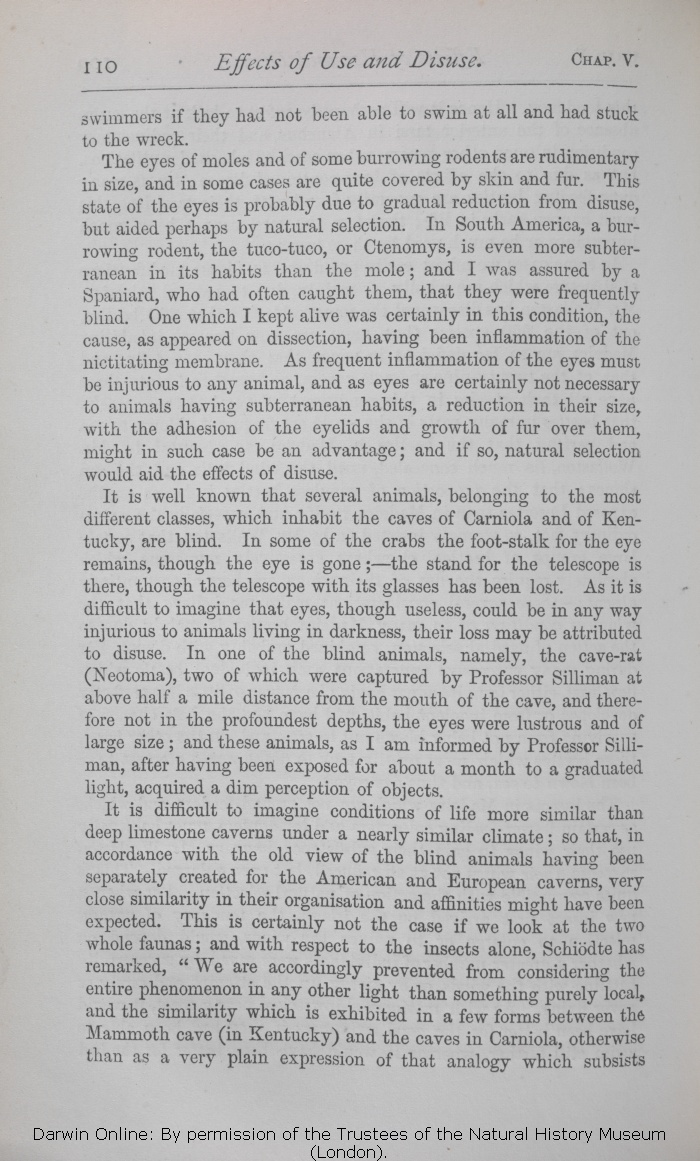|
swimmers if they had not been able to swim at all and had stuck to the wreck. |
|
The eyes of moles and of some burrowing rodents are rudimentary in size, and in some cases are quite covered
..| ..... 1872 | | up 1859 1860 1861 1866 1869 |
| blind. 1872 | | blind; 1859 1860 1861 1866 1869 |
| One 1872 | | one 1859 1860 1861 1866 1869 |
| I 1859 1860 1861 1866 1872 | | 1 1869 |
| necessary 1869 1872 | | indispensable 1859 1860 1861 1866 |
| having 1869 1872 | | with 1859 1860 1861 1866 |
| size, 1866 1869 1872 | | size 1859 1860 1861 |
| ..... 1872 | | constantly 1859 1860 1861 1866 1869 |
|
|
It is well known that several animals, belonging to the most different classes, which inhabit the caves of
Carniola | Carniola 1861 1866 1869 1872 | | Styria 1859 1860 |
| gone;— 1872 | | gone; 1859 1860 1861 1866 1869 |
| ..... 1872 | | I attribute 1859 1860 1861 1866 1869 |
| may be attributed 1872 |
| wholly 1859 1860 1861 1866 1869 |
| cave rat (Neotoma), two of which were captured by 1872 |
| cave-rat, the eyes are of immense size; and 1859 1860 |
| cave-rat (Neotoma), two of which were captured by 1861 1866 1869 |
| at above half a mile distance from the mouth of the cave, and therefore not 1861 1866 1869 1872 |
| thought that it regained, after living some days 1859 1860 |
| profoundest depths, the eyes were lustrous and of large size; and these animals, as I am informed by Professor Silliman, after having been exposed for about a month to a graduated light, acquired a dim perception of objects. 1869 1872 |
| light, some slight power of vision. 1859 1860 |
| profoundest depths, the eyes were lustrous and of large size; but these animals, as I am informed by Professor Silliman, having been exposed for about a month to a graduated light, acquired a dim perception of objects when brought towards their eyes, and blinked. 1861 1866 |
| 1 blocks not present in 1861 1866 1869 1872; present in 1859 1860 | | In the same manner as in Madeira the wings of some of the insects have been enlarged, and the wings of others have been reduced by natural selection aided by use and disuse, so in the case of the cave-rat natural selection seems to have struggled with the loss of light and to have increased the size of the eyes; whereas with all the other inhabitants of the caves, disuse by itself seems to have done its work.
|
|
|
It is difficult to imagine conditions of life more similar than deep limestone caverns under a nearly similar climate; so
that, | that, 1866 1869 1872 | | that 1859 1860 1861 |
| in accordance with the old 1872 |
| on the common 1859 1860 1861 1866 1869 |
| very close 1861 1866 1869 1872 | | close 1859 1860 |
| expected. 1861 1866 1869 1872 | | expected; 1859 1860 |
| OMIT 1869 1872 |
| but, as Schiödte and others have remarked, 1859 1860 |
| OMIT 1861 1866 |
| ..... 1869 1872 | | this 1859 1860 | | This 1861 1866 |
| ..... 1869 1872 | | is 1859 1860 1861 1866 |
| ..... 1869 1872 | | not 1859 1860 | | certainly not 1861 1866 |
| ..... 1869 1872 | | the 1859 1860 1861 1866 |
| ..... 1869 1872 | | case, 1859 1860 | | case 1861 1866 |
| OMIT 1869 1872 |
| and the cave-insects of 1859 1860 |
| if we look at 1861 1866 |
| ..... 1869 1872 | | the 1859 1860 1861 1866 |
| ..... 1869 1872 | | two 1859 1860 1861 1866 |
| OMIT 1869 1872 |
| continents are not more closely allied than might have been anticipated from the general resemblance of the other inhabitants of North America and Europe. 1859 1860 |
| whole faunas; and with respect to the insects alone, Schiödte has remarked, " 1861 1866 |
| "We 1869 1872 | | We 1861 1866 |
|









